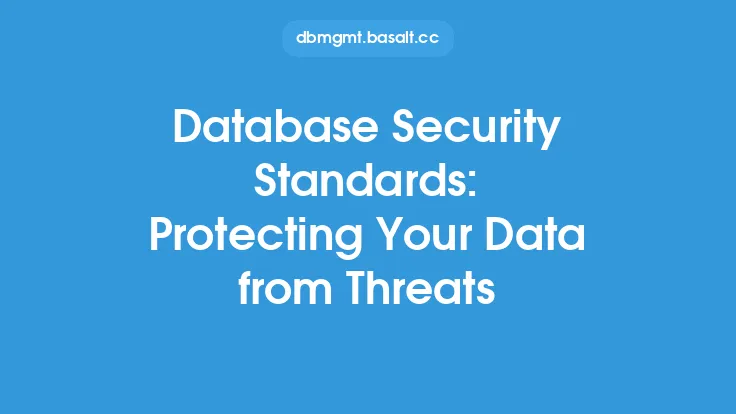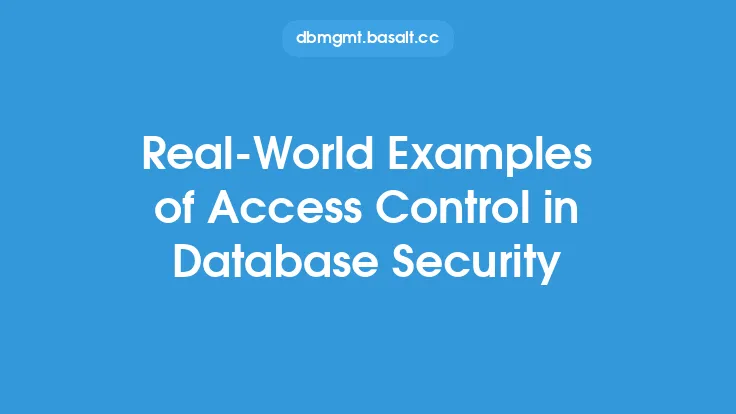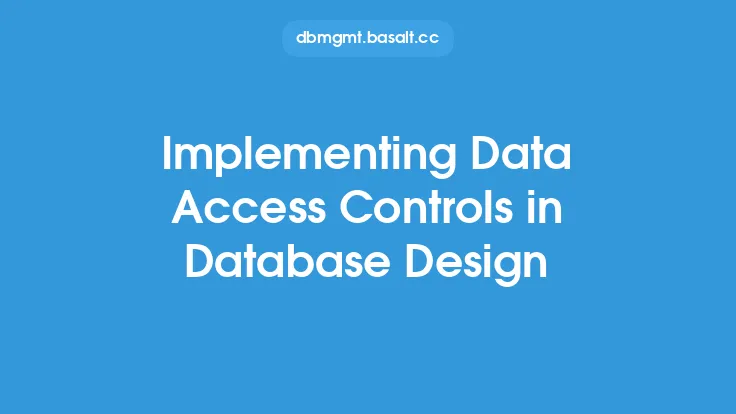Database schema security is a critical aspect of database implementation, as it ensures that sensitive data is protected from unauthorized access, use, or disclosure. A database schema is the overall structure or organization of a database, including the relationships between different tables, columns, and other database objects. Securing a database schema involves implementing various measures to prevent unauthorized access, tampering, or exploitation of the database's structure and data. In this article, we will delve into the importance of database schema security, common security threats, and best practices for protecting your database schema.
Introduction to Database Schema Security
Database schema security is essential for any organization that relies on databases to store sensitive information, such as customer data, financial records, or confidential business information. A secure database schema helps prevent data breaches, ensures compliance with regulatory requirements, and protects against various types of cyber threats. Database administrators and developers must work together to implement robust security measures that protect the database schema and its underlying data.
Common Security Threats to Database Schemas
Several security threats can compromise the integrity of a database schema, including:
- SQL injection attacks: These occur when an attacker injects malicious SQL code into a web application's database, allowing them to access, modify, or delete sensitive data.
- Unauthorized access: This can happen when an attacker gains access to the database using stolen or compromised credentials, or by exploiting vulnerabilities in the database management system.
- Data tampering: This involves modifying or deleting data in the database, which can compromise the integrity of the data and affect business operations.
- Denial of Service (DoS) attacks: These attacks overwhelm the database with traffic, making it unavailable to legitimate users.
- Insider threats: These occur when authorized personnel intentionally or unintentionally compromise the security of the database schema.
Authentication and Authorization in Database Schema Security
Authentication and authorization are critical components of database schema security. Authentication involves verifying the identity of users or applications attempting to access the database, while authorization determines the level of access granted to authenticated users. To ensure robust authentication and authorization, database administrators can implement:
- Strong passwords and password policies
- Multi-factor authentication
- Role-Based Access Control (RBAC) or Attribute-Based Access Control (ABAC)
- Least privilege access, where users are granted only the necessary permissions to perform their tasks
Encryption and Access Control in Database Schema Security
Encryption and access control are essential for protecting sensitive data in the database schema. Encryption involves converting plaintext data into unreadable ciphertext, making it inaccessible to unauthorized users. Access control, on the other hand, involves restricting access to the database and its objects based on user identity, role, or other factors. To ensure robust encryption and access control, database administrators can implement:
- Data encryption at rest and in transit
- Secure Sockets Layer/Transport Layer Security (SSL/TLS) protocols
- Access control lists (ACLs) or grants
- Row-level security (RLS) or column-level security (CLS)
Auditing and Monitoring in Database Schema Security
Auditing and monitoring are critical for detecting and responding to security incidents in the database schema. Auditing involves tracking and recording all activities performed on the database, while monitoring involves real-time surveillance of database activity. To ensure robust auditing and monitoring, database administrators can implement:
- Audit logs and trails
- Real-time monitoring tools
- Anomaly detection and alerting systems
- Regular security assessments and vulnerability scans
Best Practices for Database Schema Security
To ensure the security of a database schema, database administrators and developers should follow best practices, including:
- Implementing a defense-in-depth approach, where multiple security controls are layered to provide comprehensive protection
- Conducting regular security assessments and vulnerability scans
- Keeping the database management system and its components up-to-date with the latest security patches
- Using secure protocols for data transmission and storage
- Limiting access to the database and its objects based on user identity, role, or other factors
- Monitoring database activity in real-time and responding promptly to security incidents
Conclusion
Database schema security is a critical aspect of database implementation, as it ensures the protection of sensitive data from unauthorized access, use, or disclosure. By understanding common security threats, implementing robust authentication and authorization, encryption and access control, auditing and monitoring, and following best practices, database administrators and developers can ensure the security and integrity of their database schema. Remember, database schema security is an ongoing process that requires continuous monitoring, assessment, and improvement to stay ahead of emerging threats and vulnerabilities.





